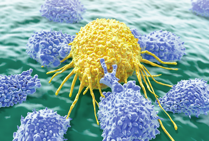Cytokine and chemokine response of primary natural killer cells were very similar in HHV-6B and HHV-7 infections. The results were starkly different for HHV-6A.
Investigators at University of Ferrara in Italy used a variety of techniques including RT-PCR, Western Blot, immunofluorescence, and flow cytometry, to analyze the effects of infection on DNA signaling and pathway expression.
HHV-6A decreased expression of TLR9 mRNA and protein, giving it an overall anti-inflammatory and immunosuppressive effect in NK cells. HHV-6B only decreased TLR9 protein synthesis. Additionally, HHV-6B increased production of other inflammatory cytokines in infected NK cells including TNFα, IL-6, and IL-8.
HHV-6A stimulated the production of mRNA for the DNA sensor protein, stimulator of interferon genes (STING), whereas HHV-6B had no effect. STING is responsible for inducing interferon alpha (INF-α) during infection. Curiously, this did not result in an increase in STING protein indicating that the mRNA produced during HHV-6A infection gets degraded rather than expressed. The authors suggest that this benefits the virus by increasing availability for viral transduction.
These findings help elucidate the mechanisms of infection for HHV-6 and the specific on the immune system. The ability to distinguish these mechanisms between HHV-A and HHV-6B are important to better understanding the implications of HHV-6 infection in other diseases.
Read the full text: Bortolotti 2020

